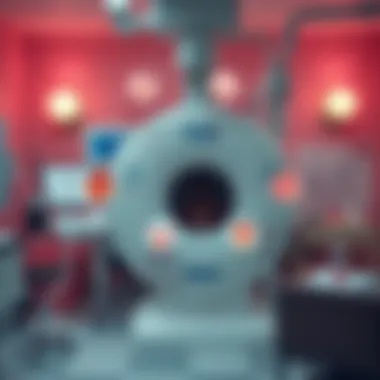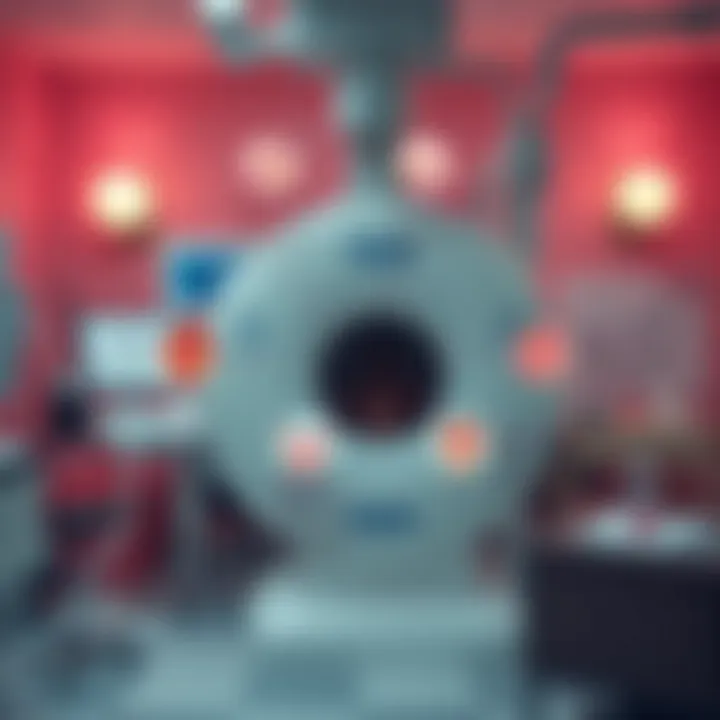Understanding the Side Effects of Vaginal Radiation Therapy


Intro
Vaginal radiation therapy emerges as a crucial component in the management of certain gynecologic cancers. For patients, understanding the potential side effects of this treatment is just as vital as the treatment itself. While the primary aim is to target malignancies, patients often encounter a range of physiological and psychological changes that can significantly affect their quality of life. This article seeks to unravel the complexities associated with vaginal radiation therapy, detailing its side effects and guiding patients in navigating these challenges.
From short-lived reactions such as fatigue and skin irritation to long-term effects including changes in vaginal tissue, the consequences of this therapy are manifold. A proactive approach to managing these side effects can make a world of difference, not only in terms of physical well-being but also emotional resilience.
As we dive deeper into this topic, we will highlight key findings from recent research, discuss the relevance these findings have for clinical practice, and provide insight into the methodologies employed in studying these effects. By creating awareness, we aim to foster better communication between patients and healthcare providers to optimize care and support throughout the treatment journey.
Prologue to Vaginal Radiation
Vaginal radiation therapy is an integral component of the treatment landscape for certain cancers, specifically in targeting malignancies that affect the reproductive organs. It's essential to appreciate not just the therapy itself but also the nuances of how it functions in a broader oncological context. Important considerations include the range of conditions it addresses, the mechanisms it employs, and its role in enhancing patient outcomes. Understanding vaginal radiation therapy leads to informed discussions about the potential side effects and overall patient well-being.
Role of Radiation in Cancer Treatment
The use of radiation in cancer treatment is steeped in its effectiveness at targeting and destroying cancer cells, thereby shrinking tumors and preventing their spread. Radiation treatment has evolved considerably, incorporating various techniques such as external beam radiation and brachytherapy, which involves placing a radioactive source inside or next to the treatment area.
This precise targeting is crucial because it strives to minimize damage to surrounding healthy tissue, which can often be a collateral casualty in the war against cancer. The role of radiation therapy is vital, as it can be curative, used alone or in conjunction with surgery and chemotherapy to improve outcomes. The potential for reducing tumor size often means an increased chance for patients to avoid radical surgical measures.
Overview of Vaginal Radiation Therapy
Vaginal radiation therapy specifically refers to delivering radiation directly to the vagina and surrounding structures as a localized treatment option. It primarily addresses cancers such as cervical, vaginal, and endometrial cancers. The key here is personalization; treatment plans are usually tailored to the specifics of the individual's cancer type, stage, and overall health condition.
Unlike systemic therapies, which affect the entire body, vaginal radiation therapy targets the cancer directly while striving to spare healthy tissue and minimize systemic side effects. This localized approach often results in an array of outcomes that need to be understood in relation to both effectiveness and the array of side effects that may emerge post-treatment.
In summary, understanding vaginal radiation therapy's role in cancer treatment is a crucial foundation for discussing its side effects. The complexity of treatment underscores the necessity of accurate patient education and ongoing support post-therapy, which becomes central as we explore the potential ramifications of this life-saving intervention.
Understanding the Mechanism of Action
Understanding the mechanism of action of vaginal radiation therapy is crucial for comprehending how this treatment option interacts with cancer cells. Not only does this knowledge help elucidate the risks and benefits associated with the therapy, but it also assists patients and healthcare providers in making informed decisions about treatment plans. In this section, we will analyze how radiation specifically targets cancer cells while also considering the impact on surrounding healthy tissue.
How Radiation Targets Cancer Cells
Radiation therapy employs high-energy waves to damage the DNA of cancer cells, inhibiting their ability to replicate and grow. The fundamental principle lies in the distinction between cancerous and normal cells. Cancer cells often divide more quickly than their healthy counterparts, rendering them more susceptible to radiation effects. When radiation penetrates the tissue, it can disrupt cellular functions, triggering a process that ultimately leads to cell death.
Of note is that not all cancer cells react uniformly to radiation. Factors such as the type of cancer, its stage, and cellular characteristics play pivotal roles in determining the therapy’s effectiveness. For instance, some cancers, like cervical or vaginal cancers, may respond well to localized radiation, allowing for targeted attack without significant harm to surrounding tissues.
- Cell Cycle Sensitivity: Cancer cells in certain phases of division are notably more impacted. Radiation is most effective during the late G2 and M phases of the cell cycle.
- Radiation Dosage: The prescribed dose is critical. Under-treatment may not fully eradicate cancerous cells, while excessive doses could lead to intolerable side effects.
In addition, advancements in the field of radiotherapy have led to techniques like intensity-modulated radiation therapy (IMRT) or image-guided radiation therapy (IGRT), which are designed to maximize damage to tumors while sparing nearby healthy cells.
Impact on Surrounding Healthy Tissue
While vaginal radiation therapy can effectively target and eradicate cancerous cells, it cannot be overlooked that some collateral damage to healthy tissue is inevitable.
Healthy tissues also absorb radiation to a degree, which can lead to side effects ranging from mild discomfort to serious complications. The impact can manifest in several forms:
- Tissue Inflammation: Healthy cells can become inflamed during treatment, leading to discomfort and irritation of the vaginal mucosa.
- Destruction of Healthy Cells: Some non-cancerous cells may experience damage, resulting in symptoms like dryness or changes in the physiology of the vagina.
- Increased Risk of Infection: As the tissue undergoes changes, the risk of infection may rise, complicating recovery and care.
- Functional Changes: Long-term impacts may include alterations in urinary and reproductive functions, which could affect a patient's quality of life long after treatment has concluded.
It's essential for patients to have candid discussions with their healthcare providers about these potential side effects. By understanding both the efficacy of targeting cancer cells and the possibility of harming healthy tissue, patients can be better prepared for what to expect during and after treatment. This knowledge may ease some anxiety surrounding the treatment plan, fostering a proactive mindset towards managing one's health.
"Knowledge is power, and understanding the intricacies of treatment can ultimately lead to more empowered decisions regarding one’s health journey."
Common Side Effects of Vaginal Radiation


Understanding the common side effects of vaginal radiation is crucial for patients and healthcare providers alike. These side effects often serve as bearers of significant insights into how the body responds to treatment. When patients are armed with knowledge about what to expect, it fosters a greater sense of control throughout their treatment journey. Moreover, recognizing these effects can lead to timely interventions, enhancing patient comfort and overall quality of life.
Physical Side Effects Overview
Patients undergoing vaginal radiation therapy may encounter several physical side effects. Initially, one may face acute symptoms such as skin irritation in the treatment area, a common response to radiation. This irritation could manifest as redness, tenderness, or even peeling skin. It’s similar to sunburn but generally limited to the area receiving treatment.
As treatment progresses, more complications may arise:
- Vaginal Dryness: Many patients report dryness, leading to discomfort during intercourse or daily activities. This can occur due to the reduction in mucosal secretions caused by radiation.
- Narrowing of the Vaginal Canal: Radiation may induce changes in the vaginal walls, potentially causing stenosis, which restricts the vaginal opening.
- Urinary Issues: Frequency, urgency, and even discomfort during urination can surface as collateral effects—radiation can affect surrounding tissues, resulting in inflammation of the bladder or urethra.
Recognizing these physical implications early on can aid in managing symptoms effectively, ensuring that patients are not caught off guard by what's to come.
Psychological and Emotional Repercussions
The journey through vaginal radiation therapy is not just marred by physical ailments; emotional and psychological effects also play a significant role. The diagnosis itself can spark anxiety and fear, but the realization of undergoing a significant treatment like radiation can amplify these feelings.
Many patients may grapple with:
- Fear of Recurrence: Constantly worrying about the cancer returning can wear heavily on one’s mental state. It feels like walking on eggshells, always on alert for potential signs.
- Changes in Body Image: Physical changes, particularly around the genital area, can foster feelings of unattractiveness or discomfort with one’s body, impacting intimate relationships and self-esteem.
- Social Withdrawal: To cope with pain or discomfort, a patient might isolate themselves, inadvertently avoiding social encounters. This withdrawal can exacerbate feelings of loneliness or depression.
"Emotions during such a time can be as overwhelming as the treatment itself. Communication and support should not be underestimated."
Effectively addressing these psychological and emotional concerns is as vital as managing physical symptoms. This dual approach ensures patients are supported holistically, underpinning their resilience during the treatment regimen.
As we further delve into other sections, the aim remains to intertwine these effects with underlying strategies for management and improvement. Connecting these dots becomes imperative in building a cohesive understanding of the post-treatment landscape.
Physiological Changes Post-Treatment
When embarking on a journey through the realm of cancer treatment, particularly with modalities such as vaginal radiation therapy, understanding physiological changes post-treatment is essential. This phase of treatment often introduces shifts within the body that can affect one’s daily life, sense of well-being, and overall health outlook. Acknowledging these changes not only enlightens patients about what to expect but also empowers them to adapt their lifestyles accordingly.
Changes in Vaginal Health
Following vaginal radiation therapy, patients frequently experience several alterations in vaginal health. Common issues include dryness, irritation, and a change in elasticity. These changes can stem from the radiation's impact on the local tissues, leading to an inflammation response and a decline in natural lubrication.
- Vaginal Dryness: Many individuals report feeling dryness during and after the treatment, which can be uncomfortable and lead to difficulties during intimate moments.
- Thinning of Vaginal Walls: Radiation can cause thinning of the vaginal lining, which may present as discomfort during sexual activity or even routine exercises.
- Increased Susceptibility to Infections: The altered environment may make one more prone to infections, as the balance of flora can be disrupted.
It's vital for patients to maintain open communication with their healthcare providers about any changes in vaginal health. Options like vaginal moisturizers or estrogen therapy may be discussed to alleviate some of these discomforts.
"Addressing post-treatment vaginal health is not just about physical comfort; it’s about restoring confidence and quality of life."
Effects on Urinary Function
Urinary function can also bear the brunt of radiation treatment. Patients may notice a variety of changes, some of which can be temporary while others might linger longer.
- Frequency and Urgency: It’s not uncommon for individuals to report an increase in urinary frequency or urgency as a direct result of radiation exposure.
- Dysuria: Painful urination can crop up as a consequence of the tissue effects from radiation.
- Potential for Urinary Incontinence: In some cases, the effects can weaken pelvic floor strength leading to occasional involuntary leakage.
Managing urinary function changes can involve a routine of pelvic floor exercises, behavioral strategies, or even medical interventions to mitigate symptoms. Engaging regularly with healthcare teams allows individuals to discover personalized solutions available to address their concerns effectively.
As time progresses, many of these physiological adjustments may evolve, and with proper support and care, patients can work towards reclaiming their comfort and control over their bodies.
Short-Term vs. Long-Term Side Effects
The journey through vaginal radiation therapy can be a two-fold experience, one that encapsulates both immediate discomfort and residual challenges that may linger long after treatment has concluded. Understanding the short-term and long-term side effects of this therapy isn’t just important; it’s crucial for patients and healthcare providers alike. The temporary effects often serve as warning signs, while the longer-term complications require proactive management and awareness.


Immediate Effects After Treatment
Upon completion of vaginal radiation therapy, patients can expect to experience a range of immediate effects. Common symptoms include fatigue, altered vaginal sensations, and potential skin reactions in the treated area.
These effects often arise from the body's initial reaction to radiation exposure. Patients may feel a heightened sense of sensitivity within the vaginal area, which could manifest as discomfort during intercourse or everyday activities. Additionally, some individuals might report changes in vaginal secretions, which can lead to dryness and irritation. This might necessitate using lubricants or moisturizers to maintain comfort.
- Fatigue: A pervasive feeling of tiredness is common immediately after treatment.
- Irritation: Localized irritation or redness can occur on the vaginal walls.
- Altered Sensations: Patients may feel an unusual sensation during intimate moments.
In this regard, open communication with healthcare providers about these immediate effects is key. Frequently, these symptoms can be managed through appropriate interventions, helping to alleviate discomfort and improve quality of life.
Chronic Issues and Late Complications
Moving beyond the initial experience of treatment, the potential for chronic issues and late complications cannot be overlooked. These effects may take time to manifest, sometimes appearing several months or years post-therapy.
Some patients may deal with long-lasting changes to vaginal health, such as ongoing dryness or narrowing of the vaginal canal, often referred to as vaginal atrophy. This occurs due to reduced elasticity caused by radiation, which can lead to painful intercourse and considerable emotional distress. Furthermore, urinary function might also be impacted, resulting in conditions like urinary urgency or incontinence.
- Vaginal Atrophy: Leads to discomfort during intercourse and significant intimacy issues.
- Urinary Problems: Chronic bladder urgency can strain daily activities and emotional well-being.
- Osteoradionecrosis: Although rare, this severe condition affects the bone, presenting a unique long-term complication for some patients.
"It’s not just about enduring treatment; understanding what comes next can make all the difference in a patient's recovery journey."
Recognizing these potential long-term effects leads to informed discussions between patients and their healthcare teams. This comprehensive approach empowers individuals as they navigate their healing process, ensuring that every concern is addressed thoughtfully and thoroughly.
Managing Side Effects Effectively
Managing side effects associated with vaginal radiation therapy is a crucial element in the journey of recovery for patients undergoing this treatment. Understanding the ramifications of side effects allows both healthcare providers and patients to work collaboratively toward improving the overall treatment experience. Effectively managing these side effects not only supports physical health but also enhances psychological well-being.
Ignoring these side effects can lead to a range of complications. Patients may experience discomfort or distress that could have been alleviated through appropriate interventions. The importance of proactively addressing side effects cannot be overstated. When patients feel supported and informed, they are more likely to engage openly in discussions about their treatment, express their concerns, and seek help when necessary.
Medical Interventions and Treatments
Several medical interventions can help mitigate the side effects of vaginal radiation therapy. These methods range from pharmacological solutions to comprehensive therapeutic approaches. Here’s a closer look at some of the more common treatments:
- Pain Management: Analgesics and anti-inflammatory medications are often prescribed for discomfort associated with treatment. Over-the-counter options like ibuprofen or prescription medications can prove effective in managing pain.
- Vaginal Moisturizers and Lubricants: Products like Replens or Astroglide can alleviate vaginal dryness, a frequent side effect of radiation. Regular use can significantly improve the comfort level during intimacy and daily activities.
- Topical Estrogens: In postmenopausal patients, localized estrogen therapies may be beneficial. They help restore vaginal tissue and elasticity, offering relief from symptoms like dryness and discomfort.
- Counseling and Support Groups: Sometimes, the emotional and psychological side effects can be as debilitating as the physical ones. Engaging with a counselor or support group can provide an essential outlet, helping patients cope with changes in their self-image and intimacy issues.
Utilizing a combination of these interventions can empower patients to regain a sense of control during their treatment journey.
Lifestyle Adjustments and Support Systems
In addition to medical treatments, integrating thoughtful lifestyle adjustments can play a pivotal role in managing side effects effectively. Here are several strategies that can pave the way for a more positive experience during and after treatment:
- Healthy Diet: Consuming a balanced diet rich in fiber, vitamins, and minerals can boost overall health and improve recovery. Foods like fruits, vegetables, whole grains, and lean proteins support the body in healing and may help combat fatigue.
- Regular Exercise: Physical activity, even light activities like walking or yoga, can enhance mood, reduce fatigue, and improve circulation. Establishing a gentle exercise routine can help patients feel more energized and resilient.
- Hydration: Staying well-hydrated is essential to counteract side effects such as dryness. Drinking sufficient water can improve skin health and overall bodily function.
- Social Connections: Maintaining strong social ties through friends and family can provide emotional support. Engaging with loved ones or surrounding oneself with a support system can help alleviate feelings of isolation, which often accompany treatment challenges.
Understanding the impacts of radiation therapy and the associated side effects allows patients to make informed choices about their health. By blending medical interventions with lifestyle changes, the experience during and after treatment can markedly improve. Communication between patients and healthcare providers remains a linchpin in this journey, as it fosters an atmosphere where concerns can be shared and addressed.
In sum, managing side effects effectively transforms the treatment experience and nurtures the patient’s overall well-being. Awareness and proactive approaches lead to better outcomes, physically and emotionally.
Importance of Patient-Provider Communication
Effective communication between patients and healthcare providers plays a vital role in the overall experience of vaginal radiation therapy. The exchange of information fosters a trusting relationship, encouraging patients to feel comfortable sharing their concerns and needs. When patients articulate their experiences and symptoms openly, healthcare providers can tailor treatment plans that better address the unique challenges faced by each individual.
Discussing Concerns and Symptoms
Patients often enter treatments like vaginal radiation therapy with numerous concerns and uncertainties. Maybe they are worried about potential side effects or how their daily lives will be affected. Open dialogue about these issues helps demystify the process.


Providers can take a proactive approach by inviting patients to discuss specific symptoms they may experience during treatment. For example, if a patient mentions increased discomfort or anxiety, the provider can suggest adjustments or referrals to specialists for further support. This dialogue serves dual purposes: it reassures patients and aids providers in monitoring treatment effectiveness.
- “Patients should never feel like they’re just another number; every conversation is an opportunity for personalized care.”
Collaborative Care Approaches
A cooperative approach to care not only involves physicians but also extends to a multidisciplinary team that includes nurses, psychologists, nutritionists, and physical therapists. When each member of the healthcare team is aligned in their strategies, patients receive a more comprehensive care package that considers their physical and emotional well-being.
- Coordination of Care: Regular team meetings involving all care providers ensure that everyone is on the same page about the patient's progress and adjustments in treatment plans.
- Patient Involvement: Encouraging patients to participate in decision-making can lead to better outcomes. When patients feel involved, they are more likely to adhere to treatment protocols.
- Resource Sharing: Collaboration allows providers to share resources such as educational materials, referral contacts, or support group information that empowers patients navigating their therapies.
Overall, involving patients in communication and care enhances their ability to manage side effects effectively and improves satisfaction with the treatment process.
Research and Future Directions
Importance of Research and Future Directions
Research in the realm of vaginal radiation therapy is crucial for several reasons. Understanding the side effects associated with this treatment not only enhances patient care but also informs the development of better management strategies. As studies continue to emerge, they shed light on the complexities of how radiation affects individuals, paving the way for improved outcomes.
One particular area of focus is the exploration of long-term effects. Patients often live for years after treatment, so knowing the potential late-onset issues can help tailor follow-up care. This is especially important as these insights can lead to preemptive measures that mitigate adverse impacts on quality of life.
Further, ongoing research into patient perspectives on side effect management can significantly elevate the dialogue between patients and healthcare providers. The goal should always be to foster a collaborative approach in treatment decisions that align with patients' lifestyles and values.
Current Studies on Side Effect Management
Current studies address various facets of managing side effects from vaginal radiation therapy. Many researchers are investigating innovative approaches that go beyond traditional medical interventions. Areas of interest include:
- Targeted therapies: Researchers are exploring how specific medications can alleviate symptoms without compromising cancer treatment efficacy.
- Integrative therapies: This includes techniques such as acupuncture or mindfulness practices that may help in diminishing the emotional and psychological toll on patients.
- Patient education programs: Developing materials and workshops geared towards empowering patients to understand their treatment options can promote better coping strategies.
Understanding these efforts is vital, as it illustrates a shift towards a more personalized care model. The objective of these studies isn’t just to treat symptoms but to enhance the overall well-being of patients, which ultimately can have far-reaching benefits.
Advancements in Radiation Techniques
Technological advancements in radiation therapy are redefining how practitioners approach treatment for conditions requiring vaginal radiation. Enhancements in techniques have made it possible to maximize effectiveness while minimizing harm to surrounding healthy tissue. Some noted advancements include:
- Intensity-Modulated Radiation Therapy (IMRT): This technique allows for highly precise targeting of tumor sites while sparing adjacent healthy areas, potentially reducing side effects.
- Image-Guided Radiation Therapy (IGRT): Utilizing real-time imaging to ensure that radiation is delivered with utmost accuracy, reflecting changes in tumor positioning over time.
- Proton Therapy: This method uses protons rather than traditional X-rays and is known for better focusing on tumors and limiting radiation exposure to healthy tissues.
Each of these advancements presents unique opportunities for reducing the incidence and severity of side effects in patients undergoing treatment. However, their effectiveness continues to be a focal point of ongoing research, emphasizing that the pursuit for optimal patient outcomes is an ever-evolving journey.
Research doesn't just open up new avenues of treatment; it also lays the groundwork for better patient experiences during and after cancer care.
Concluding Remarks
The examination of side effects from vaginal radiation therapy underscores a critical dimension of patient care. This topic carries significant weight owing to the complex interplay between treatment benefits and the physiological and emotional toll experienced by patients. Emphasizing a holistic view is not merely a suggestion; it is an imperative to enhance both the outcomes and quality of life for those undergoing such treatments.
The Holistic Approach to Patient Care
Taking a holistic approach in patient care encompasses understanding the entirety of a patient’s experience during treatment. This perspective advocates for integrating physical, emotional, and social well-being into one’s treatment plan. For instance, addressing immediate concerns such as discomfort and psychological stress can alleviate some burdens while fostering a more positive outlook on treatment efficacy.
- Physical Assessment: It entails not just evaluating the radiation effects but also monitoring other health markers that might be affected.
- Emotional Support: Psychological therapy or counseling can provide patients with coping mechanisms to navigate anxiety and fear, which frequently arise during and after treatment.
- Community Involvement: Support groups can be invaluable. Having platforms where patients can share experiences and learn from one another can foster a sense of belonging and understanding that mitigates feelings of isolation.
Furthermore, this type of patient care champions personalized treatment plans. What works for one patient may prove less effective for another. Ongoing dialogue between healthcare providers and patients is essential, ensuring that each person's unique concerns and values are prioritized. This can ultimately translate into healthier coping strategies and better treatment adherence.
Encouraging Informed Decision-Making
Informed decision-making emerges as a fundamental element throughout the treatment journey. Patients equipped with actionable information about potential side effects can engage more fully in their care plans. This empowerment fosters a sense of agency, allowing patients to approach their treatment decisions more confidently.
To facilitate informed decision-making:
- Education is Key: Patients should be presented with clear, straightforward information about the various side effects they may encounter. This includes discussing both common and less frequently encountered issues, ensuring no stone is left unturned.
- Health Literacy: It's paramount to provide information in accessible language. Employing diagrams, videos, or even interactive tools can aid understanding, particularly for those from diverse educational backgrounds.
- Encouraging Questions: A supportive environment where patients feel comfortable asking questions can unearth concerns that might not have been previously discussed. This two-way street in communication nurtures trust and transparency.



